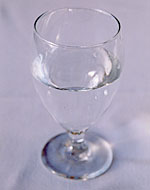Because there are variables beyond my control (clays, papers, water, mixing errors and etc) always pre test fire what you have before a big project. No guarantee can be offered that 'alternative" commercial paperclays now on the market will meet the all the performance advantages of my high performance trademark P'Clay® brand only available from licensed manufacturers/distributors.

On Site Hands On Test
The idea sounded good in theory but a "reality check" with clays, papers, factory, and kiln fire was imperative to prove a right water flow rate in the paperclay ceramic water filters did in fact occur.
Early stage success promises that further serious research is worthwhile to undertake.
With Ron Rivera at Filtron on site in a village "factory" we manufactured and fired ceramic water filters with local clay and Managua City recycled newsprint pulp. I shared my paperclay manufacture "know how" and technology with the team. Jon shared his "know how" about factory production and adaptation for paperclay also.
Our research team included, at my invitation, industry and environmental specialist from Sonoma Tile, Jon Williams, and Kya Williams.
Funding for this collaboration week work period was shared by New Century Arts, Inc (from the royalties of P'Clays®), Potters for Peace, and Sonoma Tile of California.
![]() research areas
research areas
Ongoing R&D Need for Refinement of Sustainable Materials
Applications Beyond Art
Low cost medicines can be extracted from nano-porous compounds of paperclay ceramic. Design advantage saves money and time in production. Learn More.

.
![]()
Let's Stay in Touch
Early Stage Research Water Filtration: Nicaragua Project
Ron Rivera and Team Preparing Recycled Newsprint Pulp during the Research Work-around, Managua, Nicaragua 2004
Ron Rivera and team are stirring pulp from shredded Managua newsprint in buckets of water with a drill and propeller blade attachment. After a half hour, or so, the soupy mix turned back into a grey pulp that could be collected in a simple kitchen sieve see below, and later blended in a special way with a slurry from of the ubiquitous local terra cotta clay. The method pictured below was the simplest way to make the smaller batch of recycled pulp needed for our first test recipes. The ink in the pulp will burn away in the fire.
..jpg)
Practical Considerations: Ron reported problems with lumps or flecks of not pulped paper in the resulting paperclay. My suggestion is: Shredded or torn up pieces of paper must be further broken down/stirred/beaten in water back to a pulp form. Pre-sorting the paper first helps because some colored inks, shiny gloss coatings, etc. take more time with the mixer to turn back into a pulp than others. So flecks of paper like those shown below indicate the recycling pulp is only 80% ready. To avoid lumps do not stop mixing pulp paper in plenty of water until all the flecks are gone. Waste water from this process can be reused for more pulp making, for clay mixing, or for garden, etc.
.jpg)
The method used for ceramic water filters in past was typically to add sawdust, rice husks, or other combustibles in the clay. After fire these leave air-pockets and make the fired clay porous. The dust from the sawdust used, for example, is not easy to breathe. This water system for paperclay pulp and slurry inhibits dust and saves many steps to streamline clay manufacture too.
Please contact me for more technical information. read more>>>>>